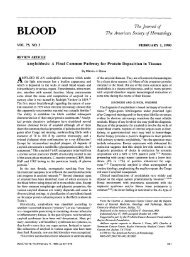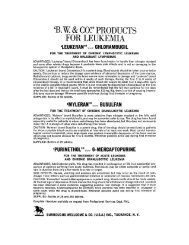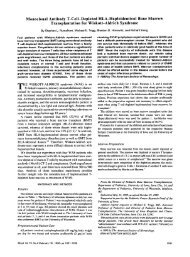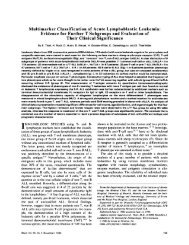Platelet Life Span in Normal, Splenectomized and ... - Blood
Platelet Life Span in Normal, Splenectomized and ... - Blood
Platelet Life Span in Normal, Splenectomized and ... - Blood
You also want an ePaper? Increase the reach of your titles
YUMPU automatically turns print PDFs into web optimized ePapers that Google loves.
From www.bloodjournal.org by guest on April 28, 2015. For personal use only.<br />
<strong>Platelet</strong> <strong>Life</strong> <strong>Span</strong> <strong>in</strong> <strong>Normal</strong>, <strong>Splenectomized</strong><br />
<strong>and</strong> Hyperspienic Rats<br />
By PETER F. HJORT AND HELEN PAPUTCHIS<br />
T HE PLATELETS are produced <strong>in</strong> the bone marrow, circulate <strong>in</strong> the<br />
blood for a number of days, <strong>and</strong> then disappear. Their eventual fate<br />
is not known. Conceivably, the spleen might be an important site of platelet<br />
destruction, <strong>and</strong> the <strong>in</strong>creased platelet level follow<strong>in</strong>g splenectomy might<br />
be due to a decreased destruction of platelets. Likewise, the decreased level<br />
<strong>in</strong> hypersplenism might be due to an <strong>in</strong>creased destruction.<br />
One approach to this problem is to label platelets <strong>in</strong> vitro, <strong>and</strong> then study<br />
their localization <strong>in</strong> the normal animal. The spleen conta<strong>in</strong>s a considerable<br />
amount of the label <strong>in</strong> such experiments,14 apparently support<strong>in</strong>g the concept<br />
that the spleen normally destroys a large fraction of platelets. However, this<br />
evidence may be criticized on the grounds that <strong>in</strong> vitro label<strong>in</strong>g <strong>and</strong> h<strong>and</strong>l<strong>in</strong>g<br />
may damage the platelets <strong>and</strong> lead to abnormal tissue localization. The body<br />
may h<strong>and</strong>le its own <strong>in</strong>tact platelets differently.<br />
Another approach to the problem is to study the possible <strong>in</strong>fluence of the<br />
spleen on the platelet life span by <strong>in</strong> vivo tagg<strong>in</strong>g. If the spleen is the ma<strong>in</strong><br />
destructor of platelets, their life span might be prolonged after splenectomy,<br />
all(l shortened <strong>in</strong> hypersplenism. Follow<strong>in</strong>g this approach, we have found<br />
the platelet life span to be the same <strong>in</strong> normal, splenectomized, <strong>and</strong> hypersplenic<br />
rats.<br />
MATERIALS AND METHODS<br />
Male Sprague-Dawley rats were used. The average weight was 375 Gm. (290 to 485<br />
Gm. ) <strong>and</strong> was the same <strong>in</strong> the normal as <strong>in</strong> the abnormal groups. Splenecto<strong>in</strong>y was done<br />
under ether anesthesia, <strong>and</strong> all rats recovered promptly without suppuration. Shamsplenectomy<br />
was done on control animals <strong>in</strong> a similar manner, a piece of omentum be<strong>in</strong>g<br />
removed <strong>in</strong>stead of the spleen. Hypersplenism was produced by <strong>in</strong>jections of methylcellulose.5<br />
Each rat was given 1.95 Gm. of methylcellulose over 24 weeks; 39 <strong>in</strong>traperitoneal<br />
<strong>in</strong>jections of 2 ml. 2.5 per cent Methocel#{176} ( 400 centipoise ). No rats died, hut toward the<br />
end of the experiment they lost weight <strong>and</strong> appeared chronically ill.<br />
Label<strong>in</strong>g of platelets-The platelets were labeled <strong>in</strong> vivo by an <strong>in</strong>tramuscular <strong>in</strong>jection<br />
of radioactive diisopropylfluorophosphate (DFP3) f6 <strong>in</strong> water-free propylene glycol. The<br />
specific activity at the time of <strong>in</strong>jection was 165 to 188 jtc. per iig. Tile <strong>in</strong>jected dose was<br />
planned to be 400 sg. of DFP32 per Kg. rat, but <strong>in</strong> retrospect the dose was estimated to be<br />
at most 130 g. per Kg. The reason for this discrepancy is that our analyses of the DFPS2<br />
preparations differed from those of the producer. We measured the I)FP content by a<br />
Seattle,<br />
From the Department of Medic<strong>in</strong>e, University of Wash<strong>in</strong>gton School of Medic<strong>in</strong>e,<br />
Wash.<br />
This <strong>in</strong>vestigation was supported by a research grant from the American Cancer Society<br />
( MKI-2A).<br />
Submitted Apr. 27, 1959; accepted for publication June 28, 1959.<br />
#{176}DowChemical Company, Midl<strong>and</strong>, Mich.<br />
t Mann<strong>in</strong>g Research Laboratory, 27 Jlajdw<strong>in</strong> Road, Valthani, Mass,<br />
45
From www.bloodjournal.org by guest on April 28, 2015. For personal use only.<br />
46 HJORr AND PAPUTCHIS<br />
nlotlification of the method of Marsh <strong>and</strong> Neale,7 <strong>and</strong> correlated the results with the total<br />
phosphonis <strong>in</strong> the preparations. These two determ<strong>in</strong>ations agreed closely, <strong>and</strong> <strong>in</strong>dicated that<br />
the preparations conta<strong>in</strong>ed only one-third or less of the stated DFP content. The purity <strong>in</strong><br />
terms of phosphorus was 78 per cent or bettcr.<br />
Count<strong>in</strong>g of platelets-The method of Brecher et al.8 was used <strong>and</strong> each sample was<br />
ounted <strong>in</strong> duplicate. The coefficient of variation as determ<strong>in</strong>ed from 306 duplicate<br />
counts was 6.8 per cent.<br />
Glassware-All glassware was freshly coated with silicone.’<br />
Collection of blood-The rat was anesthetized with ether. As it stopped breath<strong>in</strong>g, the<br />
ai)dOnlen was opened <strong>and</strong> blood collected from the vena cava. A 10 ml. syr<strong>in</strong>ge with a 21<br />
gage needle coatetl with NIonocote Ef was used. The syr<strong>in</strong>ge conta<strong>in</strong>ed 0.4 ml. of a 5<br />
per cent solution of tlisodium vcrsenatef <strong>in</strong> water, adjusted to pH 6.5 The blood as collected<br />
by slow suction for about 20 seconds; the average amount obta<strong>in</strong>ed was 8.1 ml.<br />
( 5.4 to 1 1 . 1 nil. ) . \Vith slower aspiration, more blood coultl be obta<strong>in</strong>ed, but this led to<br />
clump<strong>in</strong>g of the platelets.<br />
ISolatlOfl of platelets.-DFP is not a specific platelet label : 24 hours after the <strong>in</strong>jection<br />
the platelets carried only about 0.3 per cent of the total activity <strong>in</strong> whole blood. The<br />
isolation procedure must therefore give a high yield of uncontanl<strong>in</strong>atetl, but not necessarily<br />
viable, platelets. By differential centrifugation of undiluted rat blood only 20 to 30 per cent<br />
of the platelets were isolateti. Dextran <strong>in</strong>creased the yield, but also the contam<strong>in</strong>ation with<br />
red cells. Dilution with sal<strong>in</strong>e proved to be the most convenient way to facilitate the separation<br />
of platelets, <strong>and</strong> the follow<strong>in</strong>g methotl was used.<br />
The blood collected was transferretl <strong>in</strong>to two 15 ml. gratluated tul)es, conta<strong>in</strong><strong>in</strong>g 3 to<br />
5 1131. each. Two to three ml. of 0.9 per cent sal<strong>in</strong>e were added to each tube, <strong>and</strong> the<br />
tui)eS were centrifuged at 800 rpm ( 150x g. ) for 20 m<strong>in</strong>utes at 20 C. The platelet-rich<br />
supernatant was cOliecte(l with a capillary pipet. Gentle suction as used, <strong>and</strong> care was<br />
taken not to disturb the red cells. However, the loose upper layer of the buffy ciat was<br />
collected, s<strong>in</strong>ce it conta<strong>in</strong>ed masses of platelets <strong>and</strong> only occasional white cells. Another<br />
2 to 3 ml. of sal<strong>in</strong>e were then added to the rema<strong>in</strong><strong>in</strong>g red cells, <strong>and</strong> the tubes were<br />
centrifuged at 650 rpm ( lOOx g. ) for 20 m<strong>in</strong>utes at 20 C. The supernatant was col-<br />
Icetetl <strong>in</strong> the same manner <strong>and</strong> added to the first supernatant. The volume of the comb<strong>in</strong>ed<br />
supernatants was measured, <strong>and</strong> the number of platelets, red <strong>and</strong> white cells counted.<br />
The platelet-rich mixture of plasma <strong>and</strong> sal<strong>in</strong>e was then centrifuged at 3000 rpm. ( 2100X<br />
g. ) for 30 m<strong>in</strong>utes at 20 C. <strong>in</strong> a 40 ml. centrifuge tube, <strong>and</strong> the supernatant decanted. The<br />
supernatant was practically free of platelets. The platelet button was washed three times<br />
<strong>in</strong> 10 ml. portions of sal<strong>in</strong>e.<br />
The centrifuge tubes must conta<strong>in</strong> about the same amount of blooti each time, otherwise<br />
the effective radius <strong>and</strong> hence the centrifugal force will vary too much. An optimal<br />
amount of sal<strong>in</strong>e must be used ( 2.5 to 3 ml. sal<strong>in</strong>e to 4 ml. blood ) , s<strong>in</strong>ce too little sal<strong>in</strong>e<br />
decreased tile yield, anti too much <strong>in</strong>creased the contam<strong>in</strong>ation with red cells. If low<br />
temperature is useti, the centrifugal force must be <strong>in</strong>creased. To <strong>in</strong>sure a constant<br />
high yield, it was necessary to carry out two successive separations. In one series, for<br />
<strong>in</strong>stance, the first separation gave an average yield of 63 per cent ( 44 to 85 per cent ) . The<br />
platelets from the second separation brought the yield to 74 per cent (61 to 88 per cent).<br />
Red <strong>and</strong> white cell contam<strong>in</strong>ation was consistently low, piovided the pipett<strong>in</strong>g was carefully<br />
done ( table 1 ). The contam<strong>in</strong>ation with plasma was studied by measur<strong>in</strong>g the<br />
radioactivity of tile wash waters. The fourth wash water was always free of radioactivity,<br />
<strong>and</strong> three wash<strong>in</strong>gs were therefore considered adequate.<br />
Mecansrenient of tile radioactivity-The platelets were f<strong>in</strong>ally resuspended <strong>in</strong> three<br />
drops of sal<strong>in</strong>e, hydrolyzed for 30 m<strong>in</strong>utes at 100 C. <strong>in</strong> 0.3 ml. of 30 per cent sodium<br />
hydroxide, <strong>and</strong> transferred quantitatively to a count<strong>in</strong>g planchet. One ml. nonradioactive<br />
O537 l)ri Film, General Electric.<br />
fArnlour Company, Chicago, Ill.<br />
Abbott Laboratories, North Chicago, Ill.
From www.bloodjournal.org by guest on April 28, 2015. For personal use only.<br />
PLATELET LIFE SPAN IN RATS 47<br />
_____________________________<br />
TABLE 1 -Results of 1 03 Consecutive Isolations ofPiateletsfroni Rat <strong>Blood</strong><br />
Average<br />
Range<br />
- Yield of platelets %: 70 50-91<br />
Contam<strong>in</strong>ation with red cells ( No.<br />
of red cells per 100,000 platelets ) : 1.2 0-14<br />
Contam<strong>in</strong>ation with white cells ( No.<br />
of white cells per 100,000 platelets ) : 0.9 0-4<br />
blood was added, the sample was dried at room temperature anti counted <strong>in</strong> an endw<strong>in</strong>tlow<br />
Greiger Mueller counter. A total of 4096 counts was cOIlll)ik-tl for each saiiiple.<br />
The background radioactivity was 24 to 26 counts per m<strong>in</strong>ute. Twenty-four hours after the<br />
<strong>in</strong>jection of DFP, the platelet samples gave 72 to 170 net counts per m<strong>in</strong>ute. The radioactivity<br />
was related to the total number of <strong>Platelet</strong>s <strong>in</strong> the comb<strong>in</strong>ed supernatants. No<br />
correction was made for the contam<strong>in</strong>ation with red anti white cells, s<strong>in</strong>ce on an average<br />
there was only one retl cell anti one white cell per 100,000 platelets ( see table 1 ).<br />
RESULTS<br />
<strong>Platelet</strong> life span <strong>in</strong> normal (111(1 splenectonhize(l rats-Thirty-six rats were<br />
used, one-half of which were splenectomized <strong>and</strong> the other half shamoperated.<br />
The rats were operated upon 14 days prior to the <strong>in</strong>jection of<br />
DFp:12. At <strong>in</strong>tervals after the <strong>in</strong>jection of DFP3, two rats were killed <strong>in</strong> each<br />
group, <strong>and</strong> the radioactivity of the platelets was measured.<br />
The number of platelets <strong>in</strong> whole blood was slightly, but significantly,<br />
higher (0.025 < P < 0.05) <strong>in</strong> the splenectomized group: 1,286,000 platelets<br />
per cu.mm. ( 1,032,000 to 1,590,000 ) as compared to 1,191,000 ( 1,031,000 to<br />
1,329,000 ) <strong>in</strong> the normal group.<br />
The platelet radioactivity decreased from day to day <strong>in</strong> both groups. The<br />
po<strong>in</strong>ts fit an exponential curve better than a straight l<strong>in</strong>e ( fig. 1 ) . In this<br />
diagram each po<strong>in</strong>t corresponds to one rat. In figure 2, each po<strong>in</strong>t represents<br />
the average of a pair of rats, <strong>and</strong> the two l<strong>in</strong>es are fitted by the method of<br />
least squares. There is no significant difference between the slopes of these<br />
two l<strong>in</strong>es ( P = 0.65 ) , suggest<strong>in</strong>g that the platelet life span is essentially<br />
the same <strong>in</strong> both groups.<br />
<strong>Platelet</strong> life s-pan <strong>in</strong> normal <strong>and</strong> hyperspienic rats-Forty rats were used;<br />
one-half was made hypersplenic, <strong>and</strong> the other was untreated. At the time<br />
of sacrifice the weight was similar <strong>in</strong> both groups, b:it the spleens were on an<br />
average six times heavier <strong>in</strong> the hypersplenic group: 4.42 Gm. ( 3.15 to 6.31<br />
Gm. ) versus 0.69 Gm. ( 0.46 to 0.93 Gm. ) . The hypersplenic rats were<br />
anemic; their average hematocrit was 37.7 ( 33.0 to 42.0) versus 45.9 ( 43.8<br />
to 50.0 ) <strong>in</strong> the normal group. They also had a slight, but significant ( P <<br />
0.01 ) thrombocytopenia : 780,000 platelets per cu.mm. ( 542,000 to 1,046,000)<br />
compared to 966,000 ( 721,000 to 1,144,000) <strong>in</strong> the normal group.<br />
Both groups were <strong>in</strong>jected with DFP:12 at the same time, <strong>and</strong> two rats <strong>in</strong><br />
group were killed at <strong>in</strong>tervals after the <strong>in</strong>jection. Figure 3 gives the<br />
I)lttelet radioactivity of the hvo groups. The data are plotted as <strong>in</strong> figure 2.<br />
each po<strong>in</strong>t is the average of two rats, <strong>and</strong> the l<strong>in</strong>es are fitted by the method<br />
of least squares. Aga<strong>in</strong>, there is no significant difference <strong>in</strong> the slope of
From www.bloodjournal.org by guest on April 28, 2015. For personal use only.<br />
48 HJORT AND PAPUTCHIS<br />
.<br />
01<br />
8 tO 2<br />
Days After Injection<br />
FIG. 1.-<strong>Platelet</strong> ratlioactivity after <strong>in</strong>jection of I)FP:5 <strong>in</strong> norusal <strong>and</strong> splenectomized rats.<br />
The same data are plotted on regular paper ( left ) anti on semilogarithmic paper ( right).<br />
Each po<strong>in</strong>t represents one rat; #{149} = nornial rats, <strong>and</strong> X = splenectomized rats. The open<br />
circles give the average for the four daily determ<strong>in</strong>ations.<br />
the two l<strong>in</strong>es ( P = 0.17 ), suggest<strong>in</strong>g that the platelet life span is the same<br />
ifl both groups.<br />
DISCUSSION<br />
The disappearance curve for labeled platelets is most often reported as a<br />
straight l<strong>in</strong>e, suggest<strong>in</strong>g a disappearance by senescence.5 However, some<br />
workers f<strong>in</strong>d an exponential curve, suggest<strong>in</strong>g a r<strong>and</strong>om destruction.’2<br />
Figure 1 shows that our data do not exactly fit either of these two types,<br />
s<strong>in</strong>ce the curves level off at an activity equal to 10 to 20 per cent of the 24<br />
hour value. Other workers6’3 also mention such residual activity. This might<br />
i)e expla<strong>in</strong>ed either by contam<strong>in</strong>ation, or by a prolonged period of label<strong>in</strong>g.<br />
The residual activity is not due to contam<strong>in</strong>ation with plasma, s<strong>in</strong>ce plasma<br />
is virtually <strong>in</strong>active eight days after the <strong>in</strong>jection; <strong>and</strong> contam<strong>in</strong>ation with<br />
reti <strong>and</strong> white cells was ruled out by microscopic exam<strong>in</strong>ations. Therefore,<br />
we believe that there is a prolonged period of label<strong>in</strong>g. This is not due to a<br />
slow release of DFP32 from the site of <strong>in</strong>jection, s<strong>in</strong>ce we found similar curves<br />
after <strong>in</strong>traperitoneal <strong>in</strong>jections. A reutilization of the label is held to be<br />
impossible,14 <strong>and</strong> we have confirmed that diisopropyl phosphate (DIP32)<br />
does not label blood cells. Therefore, we believe that the prolonged label<strong>in</strong>g<br />
is due to a gradual release of labeled platelets, probably from megakaryocytes.<br />
If this is so, only the first parts of our curves reflect the life span of the<br />
platelets <strong>in</strong>itially labeled <strong>in</strong> the circulation. Figure 1 shows that the data fit a
From www.bloodjournal.org by guest on April 28, 2015. For personal use only.<br />
PLATELET LIFE SPAN IN RATS 49<br />
1o,<br />
15#{149}<br />
S<br />
NORMAL<br />
RATS<br />
S--S SPLENECTOMIZED RATS<br />
Sc<br />
‘1<br />
Li<br />
2 4 6 8 10<br />
DAYS AFTER INJECTION<br />
FIG. 2.-<strong>Platelet</strong> radioactivity after <strong>in</strong>jection of DFP32 <strong>in</strong>to normal <strong>and</strong> splenectomized<br />
rats. Each po<strong>in</strong>t represents the average of two rats. The l<strong>in</strong>es are fitted by the method<br />
of least squares. In the normal group, the slope of the l<strong>in</strong>e corresponds to a half-life of<br />
3.0 days, with 2.4 to 4.0 days as 95 per cent confidence limits. In the splenectomized<br />
group, the half-life was 2.8 days.<br />
straight or an exponential curve, depend<strong>in</strong>g on whether the observations from<br />
the first three or from the first seven days are used. Obviously, our data do<br />
not allow conclusions regard<strong>in</strong>g the type of the life span curve, but we have<br />
drawn our curves on semilogarithmic paper to facilitate comparison of the<br />
two groups <strong>in</strong> each experiment.<br />
The platelet activity is higher <strong>in</strong> figure 3 than <strong>in</strong> figure 2. The dose was 130<br />
i’g. of DFP:2 per Kg. rat <strong>in</strong> figure 3. It was probably considerably lower <strong>in</strong><br />
figure 2, s<strong>in</strong>ce this experiment was done before we had started to control<br />
the DFP32 preparations with our own assay. Subsequent experiments with<br />
different doses of DFP32 have confirmed that higher doses result <strong>in</strong> <strong>in</strong>creased<br />
platelet activity <strong>and</strong> curves which level off at a higher activity.<br />
Our experiments show no difference <strong>in</strong> the platelet life span <strong>in</strong> normal<br />
<strong>and</strong> splenectomized rats, <strong>in</strong>dicat<strong>in</strong>g that destruction of platelets proceeds at<br />
a normal rate <strong>in</strong> other areas than the spleen follow<strong>in</strong>g removal of that organ,<br />
<strong>and</strong> that the spleen therefore must exert its effects on the production of<br />
platelets rather than on their destruction. Consistent with our observation<br />
are the previous reports of Leeksma <strong>and</strong> Cohen6 <strong>and</strong> of Gardner et al.,#{176}<br />
while Reisner et al.2 found an average life span of n<strong>in</strong>e days <strong>in</strong> splenectomized<br />
patients versus nearly seven days <strong>in</strong> normals.<br />
In hypersplenic thrombocytopenia both a normal” <strong>and</strong> a short6 platelet<br />
life span has been reported. Our hypersplenic rats had spleens which were<br />
six times larger than normal, but they had only a mild thrombocytopenia.
From www.bloodjournal.org by guest on April 28, 2015. For personal use only.<br />
50 HJORT AND PAPUTCHIS<br />
. -<br />
0<br />
NORMAL<br />
RATS<br />
5-- 5 HYPERSPLENIC RATS<br />
j 20<br />
S<br />
01<br />
S<br />
‘1<br />
Sc<br />
‘1 8<br />
2 4 6<br />
DAYS AFTER INJECTION<br />
FIG. 3.-<strong>Platelet</strong> radioactivity after <strong>in</strong>jection of DFPS2 <strong>in</strong>to normal <strong>and</strong> hypersplenic<br />
rats. Each po<strong>in</strong>t represents the average of two rats. The l<strong>in</strong>es are fitted by the method<br />
of least squares. In the normal group the slope of the l<strong>in</strong>e corresponds to a half-life of<br />
4.0 days, with 3.1 to 5.6 days as 95 per cent confidence limits. In the hyperspienic group<br />
the half-life was 5.0 days.<br />
However, to make an analogy, any significant fall of red cell concentration<br />
produces a marked <strong>in</strong>crease <strong>in</strong> the erythropoietic rate. Thus, a mild degree<br />
of anemia <strong>in</strong> hereditary spherocytosis is associated with erythropoietic rates<br />
of five to six times normal,’ <strong>and</strong> mild anemia <strong>in</strong>duced by bleed<strong>in</strong>g results <strong>in</strong><br />
<strong>in</strong>creases of three times normal. Our studies show that no such <strong>in</strong>creased<br />
state of platelet turnover is present <strong>in</strong> the hypersplenic rats with thrombocytopenia.<br />
S<strong>in</strong>ce platelet production can be <strong>in</strong>creased both <strong>in</strong> normal <strong>and</strong> <strong>in</strong><br />
splenectomized methylcellulose-treated rats,17 our results suggest that the<br />
thrombocytopenia was caused by a splenic marrow depression, rather than<br />
by <strong>in</strong>creased destruction.<br />
SUMMARY<br />
1. A method is described for the isolation of rat platelets. The method<br />
gives high yields of platelets with negligible white <strong>and</strong> red cell contam<strong>in</strong>ation.<br />
2. Rat platelets were labeled <strong>in</strong> vivo with radioactive diisopropylfluorophosphate<br />
( DFP32 ) . The platelet life span was the same <strong>in</strong> normal, splenectomized<br />
<strong>and</strong> hypersplenic rats.<br />
3. Some problems <strong>in</strong>volved <strong>in</strong> the use of DFPII as a blood cell label are<br />
discussed.<br />
SUMMARIO IN INTERLINGUA<br />
1. Es describite un methodo pro le isolation de plachettas de ratto. Illo<br />
resulta <strong>in</strong> un alter rendimento de plachettas, con negligibile grados de contam<strong>in</strong>ation<br />
leuco- e erythrocytic.<br />
2. Plachettas de ratto esseva marcate <strong>in</strong> vivo con biisopropylfluorophosphato
From www.bloodjournal.org by guest on April 28, 2015. For personal use only.<br />
PLATELET LIFE SPAN IN RATS 51<br />
a I)lo51)lor0 radioactive ( BFP:i2 ) . Le duration del vita de plachettas ab rattos<br />
normal, rattos splenectcmisate, rattos hypersplenic esseva le mesme.<br />
3. Es discutite certe problemas <strong>in</strong>herente <strong>in</strong> le uso de BFP:12 como marca<br />
pro cellulas de sangu<strong>in</strong>e.<br />
REFERENCES<br />
1. Cronkite, E. P., Bond, V. P., Robertson,<br />
J. S., <strong>and</strong> Paglia, D. E.: The survival,<br />
distribution <strong>and</strong> apparent <strong>in</strong>teraction<br />
with capillary endotheliurn of transfused<br />
radiosulfate labeleti platelets <strong>in</strong><br />
the rat. J.Cl<strong>in</strong>.Invest. 36:881, 1957.<br />
2. Reisner, E. H., Jr., Keat<strong>in</strong>g, R. P.,<br />
Friesen, C. , <strong>and</strong> Loeffier, E. : Stirvival<br />
of sodiunl chromate51 labeled<br />
<strong>Platelet</strong>s <strong>in</strong> an<strong>in</strong>lals anti man. In<br />
Proceed<strong>in</strong>gs of The Sixth Congress<br />
of tile International Society of H2matology.<br />
New York, Grune & Stratton,<br />
1956, pp. 292-293.<br />
3. Robertson, J. S., sIi<strong>in</strong>e, \V. L., <strong>and</strong><br />
Cohn, S. H.: Label<strong>in</strong>g <strong>and</strong> trac<strong>in</strong>g<br />
rat blood platelets with chromium51.<br />
Proceed<strong>in</strong>gs of Radioisotope Conference.<br />
New York, Academic Press, Inc.,<br />
1954, vol. I, 205-208.<br />
4. Odell, T. T., Jr.: Production, life span<br />
<strong>and</strong> fate of blood platelets: Studies<br />
with radioisotope label<strong>in</strong>g technics.<br />
In Proceed<strong>in</strong>gs of The Sixth Congress<br />
of tile International Society of Hematology.<br />
New York, Grune & Stratton,<br />
196, p. 294.<br />
5. Palmer, J. G., Eichwald, E. J., Cartwright,<br />
G. E., <strong>and</strong> \V<strong>in</strong>trobe, I’sI. M.:<br />
The experimental production of splenomegaly,<br />
anemia <strong>and</strong> leukopenia <strong>in</strong><br />
alb<strong>in</strong>o rats. <strong>Blood</strong> 8:72-80, 1953.<br />
6. Leeksma, C. H. \V., <strong>and</strong> Cohen, J. A.:<br />
Determ<strong>in</strong>ation of the life span of<br />
human i)lOOti platelets us<strong>in</strong>g labeled<br />
diisopropylfluorophosphonate.<br />
Invest. 35:964-969, 1956.<br />
J.Cl<strong>in</strong>.<br />
7. l’slarsh, D. J., <strong>and</strong> Neale, E.: A colonmetric<br />
method for the detection <strong>and</strong><br />
deterni<strong>in</strong>ation of certa<strong>in</strong> acid halide<br />
<strong>and</strong> acid anhydride compounds.<br />
Chem.& md. 494-495, June 1956.<br />
8. Brecher, G., Schneiderrnan, M., <strong>and</strong><br />
Cronkite, E. P.: The reproducibility<br />
<strong>and</strong> constancy of the platelet count.<br />
Am.J.Cl<strong>in</strong>.Path. 23:15-26, 1953.<br />
9. Gardner, F. H., Aas, K. A., Cohen, P.,<br />
<strong>and</strong> Pr<strong>in</strong>gle, J. C.: Investigations of<br />
the mechanisms of thrombocytopenia.<br />
Cl<strong>in</strong>ical Research Proceed<strong>in</strong>gs 6:199-<br />
200, 1958.<br />
10. Odeil, T. T., Jr., Tausche, F. G., <strong>and</strong><br />
Forth, J. : <strong>Platelet</strong> life span as meastired<br />
i)y transfusion of isotopically<br />
labeled platelets <strong>in</strong>to rats. Acta<br />
Haemat. 13:45-52, 1955.<br />
1 1. Poliycove, NI., Dal Santo, G., <strong>and</strong><br />
Lawrence, J. H. : Simultaneous measurement<br />
of erythrocyte, leukocyte,<br />
<strong>and</strong> 1)ltelet sunvival <strong>in</strong> normal sill)-<br />
jects with t<strong>in</strong>sopropyifluorophosphate<br />
( DFP32 ) . Cl<strong>in</strong>ical Research<br />
Proceed<strong>in</strong>gs 6:45-46, 1958.<br />
12. Adelson, E., Rhe<strong>in</strong>gold, J. j., <strong>and</strong><br />
Crosby, \V. H. : Studies of platelet<br />
survival by tagg<strong>in</strong>g <strong>in</strong> vico with P3.<br />
j.Lab.& Cl<strong>in</strong>.Med. 50:57()-576, 1957.<br />
13. Odell, T. T., Jr., Tausche, F. G., <strong>and</strong><br />
Gude, W. D.: Uptake of radioactive<br />
sulfate by eleillents of the 1)100(1 <strong>and</strong><br />
the bone niarnow of rats. Am.J.<br />
Physiol. 180:491-494, 1955.<br />
14. Cohen, J. A., <strong>and</strong> \Varr<strong>in</strong>ga, NI. G. P. J.:<br />
The fate of p32 labeled diisopropylfluorophosphonate<br />
<strong>in</strong> the human body<br />
anti its use as a label<strong>in</strong>g agent <strong>in</strong> the<br />
study of the turnover of blood plasma<br />
<strong>and</strong> red cells. J.Cl<strong>in</strong>.Invest. 33:459-.<br />
467, 1954.<br />
15. Giblett, E. R., Coleman, 1). H., Pirzio-<br />
Biroli, G., Donohue, i). Ni., Motuisky,<br />
A. G., <strong>and</strong> F<strong>in</strong>ch, C. A. : Erythrok<strong>in</strong>etics.<br />
Quantitative measurements<br />
of red cell production <strong>and</strong> destruction<br />
<strong>in</strong> normal subjects <strong>and</strong> patients<br />
with anemia. <strong>Blood</strong> 11:291-309, 1956.<br />
16. Coleman, D. H., Stevens, A. R., Jr.,<br />
Dodge, H. T., anti F<strong>in</strong>ch, C. A.:<br />
Rate of 1)100(1 regeneration after blood<br />
loss. A.M.A.Arcb.Int.Med. .92:341-<br />
349, 1953.<br />
17. Matter, M., Hartmann, J. R., Kautz, J.,<br />
DeMarsh, Q. B., <strong>and</strong> F<strong>in</strong>ch, C. A.:<br />
A study of thronbopoiesis <strong>in</strong> <strong>in</strong>duced<br />
ectite thmombocytopeni.i. <strong>Blood</strong> 15:<br />
174, 1960.
From www.bloodjournal.org by guest on April 28, 2015. For personal use only.<br />
1960 15: 45-51<br />
<strong>Platelet</strong> <strong>Life</strong> <strong>Span</strong> <strong>in</strong> <strong>Normal</strong>, <strong>Splenectomized</strong> <strong>and</strong> Hypersplenic Rats<br />
PETER F. HJORT <strong>and</strong> HELEN PAPUTCHIS<br />
Updated <strong>in</strong>formation <strong>and</strong> services can be found at:<br />
http://www.bloodjournal.org/content/15/1/45.full.html<br />
Articles on similar topics can be found <strong>in</strong> the follow<strong>in</strong>g <strong>Blood</strong> collections<br />
Information about reproduc<strong>in</strong>g this article <strong>in</strong> parts or <strong>in</strong> its entirety may be found onl<strong>in</strong>e at:<br />
http://www.bloodjournal.org/site/misc/rights.xhtml#repub_requests<br />
Information about order<strong>in</strong>g repr<strong>in</strong>ts may be found onl<strong>in</strong>e at:<br />
http://www.bloodjournal.org/site/misc/rights.xhtml#repr<strong>in</strong>ts<br />
Information about subscriptions <strong>and</strong> ASH membership may be found onl<strong>in</strong>e at:<br />
http://www.bloodjournal.org/site/subscriptions/<strong>in</strong>dex.xhtml<br />
<strong>Blood</strong> (pr<strong>in</strong>t ISSN 0006-4971, onl<strong>in</strong>e ISSN 1528-0020), is published weekly by the American Society of<br />
Hematology, 2021 L St, NW, Suite 900, Wash<strong>in</strong>gton DC 20036.<br />
Copyright 2011 by The American Society of Hematology; all rights reserved.













